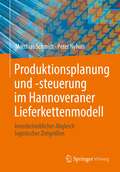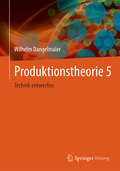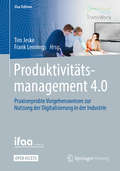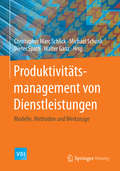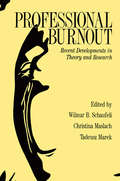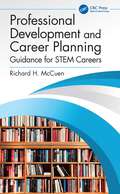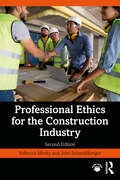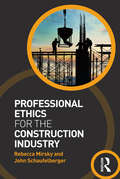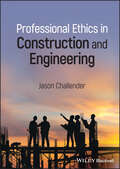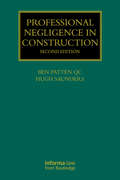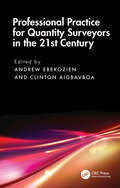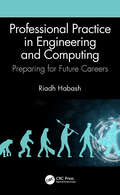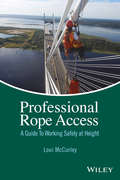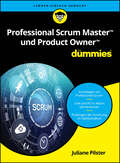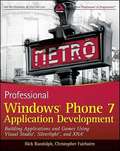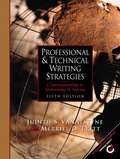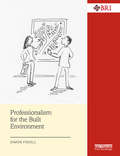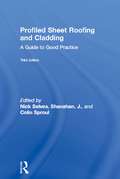- Table View
- List View
Produktionsplanung und -steuerung im Hannoveraner Lieferkettenmodell: Innerbetrieblicher Abgleich logistischer Zielgrößen
by Peter Nyhuis Matthias SchmidtDas Hannoveraner Lieferkettenmodell ist ein Rahmenmodell für die produktionslogistischen Prozesse in Unternehmen. Das Buch stellt seine Zielsysteme in den Kernprozessen der unternehmensinternen Lieferkette Beschaffung, Produktion und Versand dar und zeigt Wechselwirkungen zwischen den teilweise konträr ausgerichteten Zielgrößen auf.Anhand des Hannoveraner Lieferkettenmodells werden die verschiedenen Hauptaufgaben und Aufgaben der Produktionsplanung und -steuerung (PPS) systematisch beschrieben und in einen Gesamtkontext gebracht. Oft werden durch die Erfüllung der PPS-Aufgaben einige Zielgrößen positiv und andere negativ beeinflusst. Aufgrund dieser gegensätzlichen Wirkung der Erfüllung der PPS-Aufgaben sind unternehmerische Entscheidungen zu treffen. Hierfür werden in diesem Buch die zentralen Zielkonflikte der PPS herausgearbeitet und die Wirkung der PPS-Aufgaben auf die Zielgrößen veranschaulicht.So ermöglicht dieses Buch eine Betrachtung der Wirkzusammenhänge zwischen der Produktionsplanung und -steuerung und den logistischen Zielgrößen in der unternehmensinternen Lieferkette.
Produktionstheorie 5: Technik entwerfen
by Wilhelm DangelmaierIn dem mehrbändigen Werk zur „Produktionstheorie“ sollen erstmalig die heute aus der Praxis geborenen Produktionsmodelle und –verfahren mathematisch begründet hergeleitet und so auch der Produktionswirtschaft eine wissenschaftliche Grundlage gegeben werden. Dem „wir haben unser Unternehmen halt so organisiert und das hat sich bewährt“ soll eine konstruktivistische Sicht beiseite gestellt und so die vielen deskriptiv angelegten „Fabrikbetriebslehren“ abgelöst werden.Im vorliegenden Band 5, „Technik entwerfen“ wollen wir eine Theorie des Entwerfens von Technik angehen und uns Gedanken über das Denken und Handeln des Ingenieurs machen. Dieses Denken und dieses Handeln sind immer rekursiv: Wir entwerfen ein Technisches System‘ zur Herstellung eines Technischen Systems‘‘ zur Herstellung eines Technischen Systems‘‘‘. Das könnte bspw. das Entwerfen eines Produktionssystems zur Herstellung von Spritzgussmaschinen zur Herstellung von Haushaltföhns sein, wenn dabei initial nur festliegt, welchen Föhn der Markt letztendlich verlangt. Natürlich gibt es hier eine riesige Bandbreite möglicher Lösungen; wir brauchen nur eine, die für uns beste. Den dafür notwendigen Entscheidungs- und Auswahlprozess soll dieses Buch vorbereiten und/oder begleiten.
Produktivitätsmanagement 4.0: Praxiserprobte Vorgehensweisen zur Nutzung der Digitalisierung in der Industrie (ifaa-Edition)
by Frank Lennings Tim JeskeIn diesem Open-Access-Buch sind aktuelle Praxisbeispiele und Handlungsempfehlungen zur Gestaltung von Arbeit und Produktivität in der digitalisierten Welt beschrieben. Die Beispiele wurden von Unternehmen und wissenschaftlichen Instituten in mehreren Forschungsprojekten entwickelt und in der Praxis erprobt. Jedes Praxisbeispiel umfasst konkrete Bedarfe und Ziele, ein schrittweises Vorgehen, die Auswirkungen auf die Arbeitsgestaltung und die Produktivität sowie die zu beachtenden Erfolgsfaktoren. So sind aktuelle Gestaltungslösungen für Unternehmen beschrieben, die die Potenziale der Digitalisierung für die Arbeitswelt und das Produktivitätsmanagement praxisnah aufzeigen.
Produktivitätsmanagement von Dienstleistungen: Modelle, Methoden und Werkzeuge (VDI-Buch)
by Christopher Marc Schlick Michael Schenk Dieter Spath Walter GanzDas Buch richtet sich an Dienstleistungsmanager und -planer und beinhaltet ein Kompendium von Modellen, Methoden und Werkzeugen zur Messung, Bewertung und Steuerung der Produktivität von wissensintensiven Dienstleistungen. Neben einer modellbasierten, ganzheitlichen Betrachtung der Produktivität von Dienstleistungen werden die in empirischen Studien identifizierten Stellgrößen vorgestellt und deren Wechselwirkungen in einem System-Dynamics-Modell veranschaulicht. Des Weiteren wird eine Methode zum partizipativen Projektcontrolling eingeführt. Anhand von Fallbeispielen von international agierenden Unternehmen werden innovative Konzepte und Softwareprototypen demonstriert, mit denen auch schwach strukturierte Arbeitsprozesse, wie sie für wissensintensive Dienstleistungen typisch sind, effektiv modelliert, simuliert und optimiert werden können. Die dargestellten Modelle, Methoden und Werkzeuge sollen dem Leser als Unterstützung dienen, komplexe, wissensintensive Dienstleistungen optimal zu planen, während der Erbringung erfolgreich zu steuern und abschließend zu bewerten. Als Innovationsführer in verschiedenen wertschöpfungsstarken Branchen ist Deutschland insbesondere auf wissensintensive Dienstleistungen dringend angewiesen. Die Wettbewerbsfähigkeit der in diesem Segment tätigen Unternehmen ist bei steigendem Lebensstandard der Beschäftigten und einem latenten Mangel an Fachkräften vor allem durch eine Steigerung der Produktivität zu sichern.
Professional Burnout: Recent Developments In Theory And Research (Routledge Library Editions: Human Resource Management Ser.)
by Wilmar B. Schaufeli, Christina Maslach and Tadeusz MarekThis book provides a complete presentation of the past, present, and future of professional burnout by bringing together a set of original papers from an international group of leading scholars on burnout.
Professional Development and Career Planning: Guidance for STEM Careers
by Richard H. McCuenUndergraduate students in almost all disciplines experience curricula dominated by technical foundations, but lacking many of the "soft" topics that the students will need in order to be fully prepared to practice professionally after graduation. Professional Development and Career Planning: Guidance for STEM Careers provides the information that will enable readers to develop a more complete education and ready them for the workplace. It helps readers recognize the importance of topics such as mentoring, developing professional attitudes, communication skills, codes of conduct, ethics, becoming knowledgeable about various aspects of professional life, and more. Each chapter of the book provides the necessary definitions, hypothetical but relevant case studies, methods and practices that can be used to identify relevant professional weaknesses, and ways to overcome each of them. This book serves as an ideal reference for any undergraduate student in the STEM field. Helps readers recognize the importance of topics such as mentoring, developing important professional attitudes, and becoming knowledgeable about aspects of professional life that are not an integral part of the technical component of any curriculum. Identifies the attitudes, abilities, and skills that will be needed to optimally meet professional responsibilities. Provides information about the use of alternative methods of thinking to achieve success in problem-solving, with special emphasis on imaginative-based methods of thinking for multi-dimensional problems.
Professional Development in Science Teacher Education: Local Insight with Lessons for the Global Community (Reference Books in International Education)
by Pamela Fraser-AbderThis book explores global issues in the professional development of science teachers, and considers classroom applications of teacher training with a comparative lens. The twelve studies collected in this volume span five continents and vastly differing models of teacher education. Carefully detailing the social and cultural contexts for the teaching of science, this is a guidebook for anyone concerned with equity and reform in professional development.
Professional Ethics for the Construction Industry
by John Schaufelberger Rebecca MirskyThis second edition of Professional Ethics for the Construction Industry empowers a new generation of built environment professionals to navigate the ethical challenges confronting them at every stage of a project, from the initial bid to its completion and beyond. Authored by a pair of veteran educators and industry professionals, this textbook introduces ethical dilemmas aspiring construction professionals will face on the job—and the critical thinking skills to reason their way out of them. Written to meet curriculum requirements for all levels of construction education, this book explores ethics specific to the construction industry, illustrated by detailed and realistic case studies. All-new chapters on privacy, cutting-edge technologies, and pandemic-era worker protections complement chapters on perennial ethical issues surrounding the environment, client relationships, and more. Features include: • Completely revised and updated to reflect changes in construction technology, workforce composition, and working environments. • Updated to include new chapters on social media, privacy and technology, and construction during a disease outbreak or natural disaster. • Ideal reading for courses in professional ethics, leadership, construction law, workforce readiness, and continuing education. • Downloadable instructor's manual with commentary on scenarios provided at the end of each chapter. As vital on the jobsite as in the classroom, Professional Ethics for the Construction Industry guides aspiring design and construction professionals through the thorniest on-the-job conundrums.
Professional Ethics for the Construction Industry
by John Schaufelberger Rebecca MirskyConstruction professionals have a range of demanding responsibilities; towards clients, their companies, and to abide by government regulations. It is understandable that busy practitioners could forget their ethical responsibilities in the face of these pressures, but maintaining a rigorous ethical standard is crucial to long-term success. Written to meet the ACCE’s requirements for all construction students, this textbook draws on the authors’ industry experience, as well as detailed case studies to introduce and explore ethics in the construction industry. Within each chapter, the authors present the key ethical issues in important areas of construction management such as: Contracts and bidding Documentation Codes and Compliance Discrimination and Harassment Client Relations Lists of further reading and discussion questions will help readers at all levels to develop their understanding of this issue. Written as a resource to accompany students throughout their degrees, this is the ideal book to give students or practitioners the breadth and depth of understanding required to successfully negotiate the ethical challenges facing the construction organization of today.
Professional Ethics in Construction and Engineering
by Jason ChallenderProfessional Ethics in Construction and Engineering A comprehensive and incisive how-to guide that walks readers through the implementation of robust ethical standards in everyday construction management and decision-making Recent and high-profile incidents—including the 2017 Grenfell Tower tragedy and the Lakanal House fire in 2009—have been attributed to failures in the building construction, design, and certification industries. Some commentators have suggested that, while professional construction organizations are bound by codes of ethics, such codes may be downplayed or sometimes even ignored in the day-to-day activities of construction professionals. Professional Ethics in Construction and Engineering is a practical and industry-aligned guide on ethical practice in construction management. The book addresses how existing ethical standards should be applied in daily practice and offers case studies and examples to illustrate their effective implementation. The author also provides a toolkit that can be employed by frontline managers facing common ethical dilemmas. Readers will find: Thorough discussions of how problematic and dangerous ethical situations arise and how they should be addressed In-depth explorations of conflicts between legal and moral expectations, as well as mismatches between clients’ business goals and the duties of contracting organizations Playbooks for how impactful decisions should be made and how to uphold ethical standards and values Comprehensive review of existing ethical standards and the legal requirements binding construction professionals found in organizations like RICS, RIBA, and the CIOB A must-read document for construction management practitioners, Professional Ethics in Construction and Engineering will also be invaluable to construction clients, contractors, surveyors, and architects, as well as students of construction-related disciplines at undergraduate and postgraduate level.
Professional Ethics in Construction and Surveying
by Anthony Higham Jason Challender Peter McDermott Greg WattsThis textbook responds to the increasing demand for practical, industry aligned, ethical practices in quantity surveying, construction management and related AEC professions. Professional Ethics for Construction and Surveying addresses how existing ethical standards can be pragmatically applied to both private and contracting practice, with case studies aligned with the ethical requirements of the main professional bodies. After an introduction to ethics, the authors present real-world situations where the minimum legal and contractual requirements necessitate the combination of professional judgement and ethical decision-making. They outline how such situations arise, then address how decisions can and should be made that are in keeping with the moral, contractual and CSR requirements, with cases covering the building lifecycle from procurement to handover. Consequently, the book brings together ethical theory, existing worldwide ethical standards and the requirements of the RICS, the CIOB and the ICES, with the authors’ experiences of examining candidates for entry into the professional bodies. The result is a professionally focused textbook aimed at vocational learners (at both undergraduate and postgraduate taught levels) and practitioners in construction, engineering, architecture and the wider built environment.
Professional Negligence in Construction (Construction Practice Series)
by Ben Patten Hugh SaundersWhat is professional negligence? What are the obligations of construction professionals in contract and in tort? In what circumstances might the difference between the obligations be important? These questions are of crucial importance not only to construction lawyers but also to contractors, architects, quantity surveyors, engineers, project managers, and multi-disciplinary practitioners. With an emphasis on the practical aspects of professional negligence in the construction industry and written in a straightforward yet authoritative way, this book is ideal for lawyers and students of construction and law as well as construction professionals at all levels.
Professional Practice for Quantity Surveyors in the 21st Century
by Clinton Aigbavboa Andrew EbekozienThis book covers developing trends and changes occurring in the quantity surveying profession. It begins by explaining the construction industry structure, followed by the quantity surveying practice modalities, professional ethics, roles of regulatory bodies, continuous professional development, and code of professional conduct of quantity surveying practice. Further topics covered include international construction, contract administration, financial management, and liquidated and ascertained damages as applicable to the construction industry.Features: Considers the structure of the construction industry and the interrelationship of professionals in the built environment Provides a compendium of quantity surveying professional practice, including developing country perspectives and examples Includes information on cultural differences and how they may impact quantity surveying practices, such as communication styles, decision-making processes, and work habits Focuses on current industry trends and practices, such as sustainable practices, building information modeling (BIM), and advanced technologies Covers financial statements and progress reports regarding construction projects This book is aimed at professionals and students in construction, quantity surveying/value management, and civil engineering.
Professional Practice in Engineering and Computing: Preparing for Future Careers
by Riadh HabashThis book has been developed with an intellectual framework to focus on the challenges and specific qualities applicable to graduates on the threshold of their careers. Young professionals have to establish their competence in complying with multifaceted sets of ethical, environmental, social, and technological parameters. This competence has a vital impact on the curricula of higher education programs, because professional bodies today rely on accredited degrees as the main route for membership. Consequently, this four-part book makes a suitable resource for a two-semester undergraduate course in professional practice and career development in universities and colleges. With its comprehensive coverage of a large variety of topics, each part of the book can be used as a reference for other related courses where sustainability, leadership, systems thinking and professional practice are evident and increasingly visible. Features Identifies the values that are unique to the engineering and computing professions, and promotes a general understanding of what it means to be a member of a profession Explains how ethical and legal considerations play a role in engineering practice Discusses the importance of professional communication and reflective practice to a range of audiences Presents the practices of leadership, innovation, entrepreneurship, safety and sustainability in engineering design Analyzes and discusses the contemporary practices of project management, artificial intelligence, and professional career development.
Professional Rope Access: A Guide To Working Safely at Height
by Loui MccurleyGuides the reader in the development and maintenance of a rope access program Provides comprehensive guidance for employers, safety managers and rope access technicians to develop, maintain, and manage a rope access program Offers specific guidance for writing a comprehensive managed fall protection plan that includes rope access Thoroughly describes how to perform specific rope access maneuvers that can be used to offer greater safety when working at height Shows how a well-managed rope access program can be used as a tool to get more work accomplished at a lower cost and with greater efficiency than conventional methods can achieve Discusses and clarifies unique distinctions of equipment for rope access, as compared with equipment for fall arrest, positioning, and restraint
Professional Scrum Master und Product Owner für Dummies (Für Dummies)
by Juliane PilsterFacilitator oder Wert-Maximierer? Wo sehen Sie Ihre Stärke? Dieses Buch ist Ihr idealer Begleiter, wenn Sie sich auf die Scrum-Master- oder die Product-Owner-Zertifizierungsprüfung der Scrum.org im Selbststudium vorbereiten möchten. Es deckt die Scrum-Grundlagen, Methoden und bewährten Praktiken, die für die Prüfung relevant sind, umfassend ab. Mit Beispielen und Tipps aus der Praxis ist es schnell zugänglich und hilft Ihnen, Ihr Verständnis von Scrum zu festigen. Das Buch enthält 84 beispielhafte Übungsfragen und kommentierte Lösungen, um sicherzustellen, dass Sie optimal vorbereitet sind. Sie erfahren Welche Bedeutung Transparenz, Inspektion und Adaption in Scrum haben Was die Aufgabe des Scrum Teams ist und wie Scrum Events vor sich gehen Welche »Good Practices« Ihnen den Alltag erleichtern Wie die Zertifizierungsprüfungen ablaufen
Professional Surveyors and Real Property Descriptions
by Stephen V. Estopinal Wendy LathropThe only modern guide to interpreting and writing real property descriptions for surveyorsTechnical land information is no longer the exclusive domain of professional surveyors. The Internet now houses a multitude of resources that nontechnical professionals-such as attorneys and realtors-access and implement on a daily basis. However, these professionals are trained in aspects of law and commerce that do not provide the proper education and experience to interpret and evaluate their land boundary information discoveries correctly. As a result, their analysis is often erroneous and the data misapplied-ultimately leading to confusion and costly litigation.Professional Surveyors and Real Property Descriptions attempts to bridge the ever-widening gap between the users of land boundary information and the land surveyors who produce it. An expert team of authors integrates the historic and legal background of real property interests with fundamental concepts of the surveying profession in a manner accessible for average readers. These provide the basics for both properly comprehending older descriptions and competently constructing complete and modern real property descriptions that foster better communication. Highlights in this book include: An in-depth exploration of historic descriptions and how to read them Coverage of the widely accepted ALTA/ACSM Land Boundary Survey standards and associated property descriptions A diverse collection of examples and practice scenarios An overview of the latest issues related to the use of GPS and GISWritten in easy-to-understand language, this practical resource assists nontechnical professionals in understanding exactly what a surveyor does and does not do, and serves as a valuable tool for obtaining the most satisfactory, accurate, and complete real property descriptions.
Professional Windows Phone 7 Application Development
by Nick Randolph Christopher FairbairnA one-of-a-kind book on Windows Phone 7 developmentWhile numerous books cover both Silverlight and XNA, there lacks a resource that covers the specifics of Windows Phone 7 development. This book fills that void and shares the specifics of building phone applications and games. You'll learn how to get started with designing, building, testing, and deploying mobile applications for Windows Phone 7. Working examples used throughout the book cover how to design and layout a Windows Phone 7 application, interact with the device, and even sell your applications.Fills the void in the market for an instructional book on developing applications for Windows Phone 7Offers an overview of Windows Phone and discusses the necessary toolsExplains how to work with multiview applicationsAddresses tool bars, pickers, table views, navigation controllers, application setting, and user defaultsReviews drawing with XNA, using the camera, and understanding basic data persistenceExplore the exciting possibilties of Windows Phone 7 development with this invaluable reference.
Professional and Technical Writing Strategies: Communicating in Technology and Science (Fifth Edition)
by Merrill D. Tritt Judith S. VanalstyneThis book is designed to be used as a textbook by college and university students. However, its scope is, by design, much broader than that. It has applications for those writing in the fields of science, technology, business. It can be used by businesses to strengthen the writing abilities of those writing manuals. An excellent book with a wide range of applications. Good examples and practice exercises.
Professionalism for the Built Environment (Building Research and Information)
by Simon FoxellIn the aftermath of the Grenfell Tower tragedy, this new book provides thought provoking commentary on the nature of the relationship between society, the prevailing economic system and professionalism in the built environment. It addresses the changing responsibilities of professionals and in particular their obligation to act in the wider public interest. It is both an introduction to and an examination of professionalism and professional bodies in the sector, including a view of the future of professionalism and the organisations serving it. Simon Foxell outlines the history of professionalism in the sector, comparing and contrasting the development of the three major historic professions working in the construction industry: civil engineering, architecture and surveying. He examines how their systems have developed over time, up to the current period dominated by large professional services firms, and looks at some options for the future, whilst asking difficult questions about ethics, training, education, public trust and expectation from within and outside the industry. The book concludes with a six-point plan to help, if not ensure, that the professions remain an effective and essential part of both society and the economy; a part that allows the system to operate smoothly and easily, but also fairly and to the benefit of all. Essential reading for built environment professionals and students doing the professional studies elements of their training or in the process of applying for chartership or registration. The issues and lessons are applicable across all building professions.
Professionelles Vertriebsmanagement: Der digitalisierte Prozessansatz aus Anbieter- und Beschaffersicht
by Günter Hofbauer Enrico PurleProfessionelles Vertriebsmanagement Das Standardwerk zum Vertriebsmanagement in neuer Auflage: aktualisiert, gestrafft und ergänzt mit dem Thema Digitalisierung im Vertrieb. Dem Vertriebsmanagement kommt in der markt- und werteorientierten Unternehmensführung eine Schlüsselrolle für den Erfolg zu, denn die Unternehmen leben vom Verkauf ihrer Produkte und Dienstleistungen. Dafür ist ein profundes Verständnis der Vorgänge im Markt und bei den Kundinnen und Kunden erforderlich. Das Konzept des Customer Relationship Managements (CRM) bietet dafür die inhaltliche Basis, dessen kompetente Umsetzung im Vertriebsmanagement ist der wesentliche Erfolgsfaktor zur Erschließung der Markt- und Kundenpotenziale. Das Buch hilft Fach- und Führungskräften in Unternehmen, ihre Kompetenzen im Vertriebsmanagement zu erweitern, und Studierenden, entsprechende Kenntnisse zu erwerben. Im Vordergrund steht die zielorientierte Prozessorganisation des Vertriebsmanagements als Schlüssel zum Erfolg. Die Autoren nutzen dazu das von ihnen entwickelte Referenzmodell aus Selling Cycle und Buying Cycle und berücksichtigen damit sowohl die Anbietersicht als auch die Kundensicht. Für die vorliegende fünfte Auflage haben sie vor allem neue Aspekte der Digitalisierung entlang des gesamten Vertriebsprozesses integriert.
Professions at Bay (Routledge Revivals)
by Stirling Professions and Management Conference 1993This title was first published in 2000. This collection of works explores the sources of conflict and change which affect professional occupations, the responses of these occupations to such forces and the possible or likely outcomes of these actions and reactions for the character of British management.
Professor Branestawm Stories
by Norman HunterHe's madly sane and cleverly dotty. Professor Branestawm is the craziest genius you'll ever meet and he's back with this bumper collection of hilarious adventures, zany inventions and mind-boggling experiments. So open up for a wacky collection of stories, riddles, puzzles, tricks and tips . . . You'll never get the better of Professor Branestawn but now you can at least get the best!
Profiled Sheet Roofing and Cladding: A Guide to Good Practice
by N. W. SelvesThis guide, the third edition of the NFRCs guide to good practice, is an accessible and practical code of practice in the application, design and installation of profiled sheeting and wall and roof cladding. The UK has developed very cost-effective methods of erecting and cladding factory, warehouse and storage buildings. This book distills the knowledge of many of the leading experts in this area of construction with hands-on site experience.Profiled Sheet Roofing and Cladding, Third edition sets out principles whereby all necessary components can be successfully integrated to provide a weather-tight external envelope that meets all the required performance standards. The special requirements of insulated structures are also considered. It gives up-to-date advice and information which takes account of the exceptional requirements specified and the consequent developments which have occured since the second edition was published in 1991. Written for all construction professionals concerned with getting the best value solution for their profiled sheet clad buildings, the guide aims to assist in increasing cooperation between the designer and contractor and to inform all members of the building team about the abilities and applications of products.
Profiling Humans from their Voice
by Rita SinghThis book is about recent research in the area of profiling humans from their voice, which seeks to deduce and describe the speaker's entire persona and their surroundings from voice alone. It covers several key aspects of this technology, describing how the human voice is unique in its ability to both capture and influence the human persona -- how, in some ways, voice is more potent and valuable then DNA and fingerprints as a metric, since it not only carries information about the speaker, but also about their current state and their surroundings at the time of speaking. It provides a comprehensive review of advances made in multiple scientific fields that now contribute to its foundations. It describes how artificial intelligence enables mechanisms of discovery that were not possible before in this context, driving the field forward in unprecedented ways. It also touches upon related and relevant challenges posed by voice disguise and other mechanisms of voice manipulation. The book acts as a good resource for academic researchers, and for professional agencies in many areas such as law enforcement, healthcare, social services, entertainment etc.
